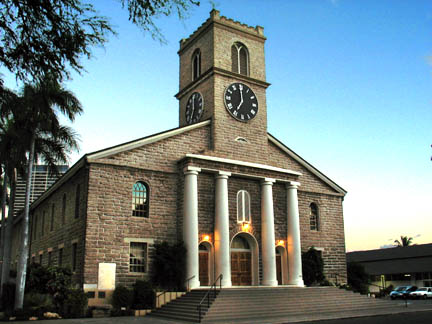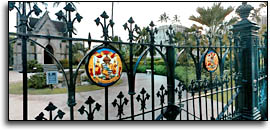
Kawaiahao is a
Protestant showplace
The great coral-block church on the corner of Punchbowl and King -- the crossroads of historic Honolulu -- is revered as the "Protestant mother church of Hawaii," ground zero in the missionaries' faith-relocation blueprint for local heathens. Architecturally, according to the National Trust application, it's of "basilican plan with tetrastyle portico of engaged austere stone Doric columns surmounted by a clock and belfry tower with castigated parapet erected over the narthex."
Got that? It might be more fun to know that the complex was once surrounded by a 6-foot coral-block wall, but after the Wailoa Revolution of 1889, when the Honolulu Rifles seized and fortified the church grounds, the wall was cut down to 2 feet.
Or that the church called Kawaiahao had several previous incarnations, each one progressively grander, and in 1836 (at the urging of Kamehameha III) the foundations of the current church were laid and supplies raised by public subscription. The cornerstone was laid in 1839, and soon after, pastor and architect Hiram Bingham was forced to leave due to poor health. Rev. Richard Armstrong presided over the dedication ceremonies on July 21, 1842. From that day to this, Kawaiahao his been an active place of worship, as well as the center of important state events and royal baptisms, marriages and funerals.
At first called Stone Church, the structure became known as Kawaiahao in 1862 and services continue to be held in both English and Hawaiian. The biggest external alteration was the erection of a more substantial bell tower in 1885, and electricity was added in 1895, a time when most American churches were still powerless.
In 1925, however, Kawaiahao was completely reconstructed because all the interior beams were termite-gutted. With the wood removed, all that was left was the coral-block shell, and concrete supports were added to the interior to minimize bracing and add a more austere, minimalist New-England simplicity. Wooden pews were made of termite-proof redwood, the pulpit and steps of recycled ohia and kauila logs, and the roof was reslated with imported stone and copper nails.
Also on the ground is the quite Victorian-gothic tomb of King Lunalilo, one of the first cement-block structures in the islands. He is buried there instead of the Royal Mausoleum because of a disagreement with other members of the royal family, just four days before his death in 1874.
Kawaiaha’o Church
Opened: 1843 Architect: Hiram Bingham Style: New England Address: 957 Punchbowl St. National Register: 1966 #66000294 (1962 NHL) Hawaii Register: No
BACK TO TOP |
Kawaiahao Church is shown in its earliest known picture circa 1856. The earliest photograph of Honolulu was taken in 1854 from the bell tower of Kawaiahao Church, looking Ewa.
The building with the bell tower is the Oahu Charity School, built in 1832 by William Paty.
The Kawaiahao Church continues to stand as a reminder of the missionary influence on Hawaiian history.
BACK TO TOP |
Quicktime VR Panorama
Click on pictures to view panaromas
BACK TO TOP |
Every Sunday in the Star-Bulletin Travel section, rediscover the charms of old Hawaii through a tour created by the Honolulu Historic Trail Committee and Historic Hawai'i Foundation and supported by the city's Office of Economic Development. The yearlong project commemorates Honolulu's bicentennial.
See Holoholo Honolulu for past articles.





